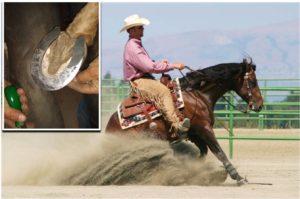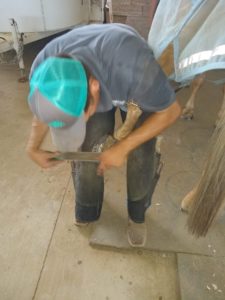Reining Horses

Reining horses must be shod in a precise way to aid the trained horse in making a sliding stop. Inset: Sliding plate on the hind foot of a Reining horse. Note the rasped off nail heads. Main picture: Mike Berg performing a sliding stop. Picture Credit: Wikipedia; By Becky Hanson – Own work, Public Domain
Reining horses have recently been in the national spotlight due to the documentary competition television show, The Last Cowboy on the Paramount Network. The Last Cowboy boasted over 800,000 viewers in the first few episodes. “The show followed the lives of riders competing in the high-stakes sport of horse reining. The contenders were determined to elevate and preserve the cowboy tradition as they guided horses through precise patterns of circles, spins and stops.” (paramountnetwork.com)
There has been a renewed interest in the reining horse competitions, but the sport is not new. Like many horse sports, Reining’s roots come from working cattle ranches. Horses had to be trained so well that they could quickly maneuver around cows to be useful to the cowboys. Horses had to be trained to be quick, easy to guide, and stop neatly on their hind legs; not their front legs! Good horses made for a smoother ride and a seamless transaction from the rider’s mind to the horse’s mind and feet.
The American Quarter Horse Association (AQHA) added reining to its official list of classes in 1950. Early patterns were a complicated maze of straight lines, turns, circles, and figure eights. They required changes in speed, flying lead changes, rollbacks, sliding stops, and backups. Competitions became more and more popular as time went on. Sandy Collier states that reining is popular because it is “fun” and it is “fun because it is so challenging.”(Sandy Collier, horsedigest.com) The popularity of reining has since extended all over the world.
Farriers shoe reining horses in a precise way to maximize a horse’s ability to perform. However, the right shoes can only make a good horse better. Shoes cannot turn a sorry horse into a champion! Occasionally, clients may ask the farrier, “Can you put sliders on my horse so she’ll slide?” Of course, the answer is that shoes won’t make a horse slide. Horses must be trained to do so and some horses have more aptitude for reining than others. The ground must also be prepared for the place that the horse performs the slide.
The front feet of reining horses can be shod with steel training plates, rim shoes, or half-round shoes. The selection of shoe usually depends on the trainer’s preference, ground condition and other uses of the horse. Half-round shoes seem to be the most popular for the professional reining horses.

The nail heads should only be rasped off after the clinching is done. This creates less drag and makes the shoe more slick.
The hind feet of reining horses are usually shod with sliding plates. Sliding plates are wide-webbed shoes that provide less traction. They are kind of like skis. Sliding plates can be bought as pre-fabricated shoes or they can be made from bar stock by a skilled farrier. Usually the bar stock is 1/4 inch thick and 1 inch wide. The length of the stock depends on the individual horse but extra steel is typically left to extend behind the heels of the foot. The toe is usually slightly beveled or “rolled.” This creates more of a ski-like effect and gives the horse’s hocks added support as it sits into the slide.
The heels on sliding plates can be bent upward or spooned to prevent the horse stepping the extended heels off. The inside heel is usually drawn a bit narrower to allow it to sink into the ground and act as a rudder. A matchstick-size piece of steel can be brazed on to the inside heel to further prevent the feet from spreading apart during the slide. (Butler, Principles of Horseshoeing (P3), pg 792)
Sliding plates are slick. This helps the horse collect its hind legs up under its body when it is reined to a stop. The rolled-toe and spooned heels reduce drag. Many owners insist on the farrier rasping the nail heads flush with the shoe to reduce drag even more. If a horse is not trained to slide or is put into really slick shoes too soon, the horse may slip and fall and reduce its confidence to try sliding in the future. The farrier must work closely with the trainer to determine the right type of shoe for the individual horse.
Most horses can be trained to stop on their hind legs and slide a foot or two. True reining horses usually slide more than 20 feet. Roy Yates trained Tidy’s Chirp, a stallion, which holds the world record for the longest sliding stop of 66 feet. (Roy Yates Horse Training Videos)
Related Posts
-
Farriers perform a valuable service for people who care abou...Apr 18, 2019 / 0 comments
-
The royal wedding in England has captured the attention and ...May 03, 2011 / 0 comments
-
“Share a little March Gladness…” We’d be “glad...Mar 09, 2010 / 0 comments
Blog Categories
- Anatomy
- Best Business Practices
- Conformation
- Current Events
- Customer Service
- Draft Horse Shoeing
- Equine Soundness
- Essential Anatomy Kit
- Farrier Careers
- Farrier training
- Foal soundness
- Horse Care
- Horse Foot Care
- Horse Owner Tips
- Horsemanship
- Horseshoeing
- Horseshoeing History
- Iron and Forge Work
- Student Spotlight
- Uncategorized
- Veterinary Care
Blog Archives
Contact Us
Butler Professional Horseshoeing School
495 Table Road
Crawford, NE 69339
(800) 728-3826
jacob@dougbutler.com
Subscribe to Our Blog
Get Our Free e-Book!
If you think you want to become a farrier (or know someone who does), this book can help you make that decision. Horse owners will learn the importance of choosing a qualified farrier and how to select the “right” one.
[ Get the e-Book Now! ]
- Follow:
